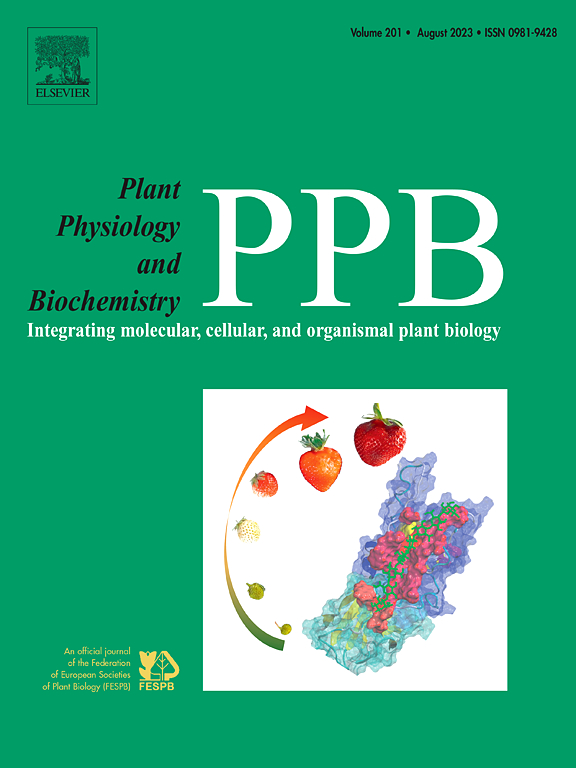An R2R3-MYB transcription factor regulates anthocyanin accumulation in response to temperature signals in Cymbidium ensifolium
IF 5.7
2区 生物学
Q1 PLANT SCIENCES
引用次数: 0
Abstract
Cymbidium ensifolium, an ornamental plant in China, is prized for its diverse flower colors and high aesthetic value. The flower color of C. ensifolium is significantly affected by temperature. In this research, we examined the impact of temperature on anthocyanin accumulation in the sepals of C. ensifolium (‘Shi Zhang Hong’) through different temperature treatments (T1, 20/15 °C, T2, 28/23 °C, T3, 36/31 °C), combined with metabolomics, transcriptome analysis and various experimental methods, screening for key temperature-responsive genes. The results indicated that high temperatures suppress both red pigmentation and anthocyanin accumulation in sepals, while low temperatures promote this process. Metabolomic analysis indicated that temperature primarily influences sepal coloration by regulating the abundance of cyanidin-3-O-glucoside. Notably, its abundance significantly increases under low temperatures but decreases at high temperatures. CeMYB52 was found to be a crucial transcription factor (TF) regulating anthocyanin accumulation by transcriptome analysis, with high expression at low temperatures and low expression at high temperatures. Remarkably, the spatio-temporal expression profiles of CeCHS8 and CeGST were aligned with CeMYB52. Through regulating the expression of CeCHS8 and CeGST, CeMYB52 contributes significantly to the promotion of anthocyanin biosynthesis and transport. Our findings offer a molecular basis for breeding temperature-resilient ornamental plants, contributing to agricultural sustainability under climate change.
R2R3-MYB转录因子对春兰花青素积累的温度信号响应进行调控
春兰(Cymbidium ensifolium)是中国的一种观赏植物,其花色多样,具有很高的审美价值。温度对金盏花的花色有显著影响。本研究通过不同温度处理(T1、20/15°C、T2、28/23°C、T3、36/31°C),结合代谢组学、转录组学分析和各种实验方法,研究温度对‘石樟红’花青素萼片积累的影响,筛选关键温度响应基因。结果表明,高温抑制了花青素和红色色素的沉积,而低温则促进了这一过程。代谢组学分析表明,温度主要通过调节花青素-3- o -葡萄糖苷的丰度来影响萼片的颜色。值得注意的是,其丰度在低温下显著增加,而在高温下显著减少。通过转录组分析发现,CeMYB52是调控花青素积累的关键转录因子(TF),低温高表达,高温低表达。值得注意的是,CeCHS8和CeGST的时空表达谱与CeMYB52一致。CeMYB52通过调控CeCHS8和CeGST的表达,显著促进花青素的生物合成和转运。我们的发现为培育适应温度的观赏植物提供了分子基础,为气候变化下的农业可持续发展做出了贡献。
本文章由计算机程序翻译,如有差异,请以英文原文为准。
求助全文
约1分钟内获得全文
求助全文
来源期刊
CiteScore
11.10
自引率
3.10%
发文量
410
审稿时长
33 days
期刊介绍:
Plant Physiology and Biochemistry publishes original theoretical, experimental and technical contributions in the various fields of plant physiology (biochemistry, physiology, structure, genetics, plant-microbe interactions, etc.) at diverse levels of integration (molecular, subcellular, cellular, organ, whole plant, environmental). Opinions expressed in the journal are the sole responsibility of the authors and publication does not imply the editors'' agreement.
Manuscripts describing molecular-genetic and/or gene expression data that are not integrated with biochemical analysis and/or actual measurements of plant physiological processes are not suitable for PPB. Also "Omics" studies (transcriptomics, proteomics, metabolomics, etc.) reporting descriptive analysis without an element of functional validation assays, will not be considered. Similarly, applied agronomic or phytochemical studies that generate no new, fundamental insights in plant physiological and/or biochemical processes are not suitable for publication in PPB.
Plant Physiology and Biochemistry publishes several types of articles: Reviews, Papers and Short Papers. Articles for Reviews are either invited by the editor or proposed by the authors for the editor''s prior agreement. Reviews should not exceed 40 typewritten pages and Short Papers no more than approximately 8 typewritten pages. The fundamental character of Plant Physiology and Biochemistry remains that of a journal for original results.

 求助内容:
求助内容: 应助结果提醒方式:
应助结果提醒方式:


